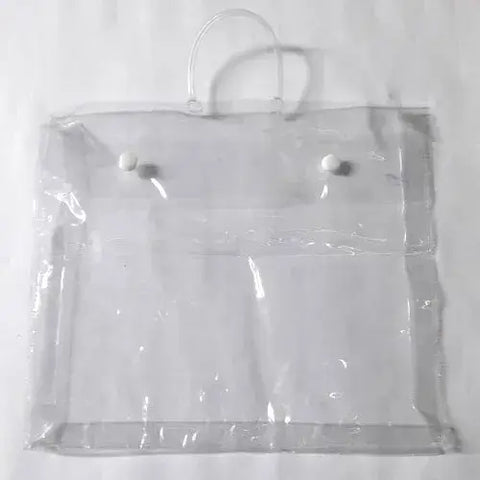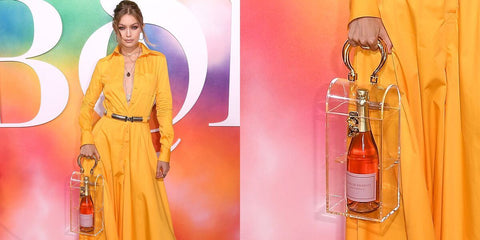Clear handbags, with their transparent PVC or vinyl fabric, allow a peek into their contents while making a bold fashion statement. Though once dismissed as a tacky fad, these bags have evolved into a versatile accessory seen everywhere from high fashion runways to everyday streetwear.

The popularity of clear bags speaks to the spirit of modern fashion - emphasizing individuality, functionality and a willingness to experiment with the unconventional. This rise did not happen overnight. In fact, transparent carryalls have a long history intertwined with major shifts in culture, technology, and the fashion industry itself.
This article will explore that evolution - from early utilitarian origins to luxury status symbol and back again - while analyzing the trend's revival in recent decades. By understanding the clear bag’s storied past, we can also glimpse its promising future at the innovative intersection of fashion, function and sustainability.
Early Origins of Clear Bags
See-through carrier bags emerged out of necessity long before the era of modern fashion. Clear pouches to hold food or belongings offered visibility and ventilation. Early examples appear in Ancient Egypt, where mesh bags contained fruits and vegetables. Transparent kanga pouches in East Africa stored personal items close at hand while allowing decorative fabrics to show. These pragmatic items later evolved with the advent of plastic materials like PVC, vinyl and acrylic in the early 20th century. Though not yet considered high fashion, their practicality and visual appeal sparked the mainstream adoption that would come decades later.

The Fashion Revolution: Clear Bags in the 20th Century
Clear bags stepped directly into the fashion spotlight in post-WWII Europe and America. Higher standards of living and technological innovations encouraged a groundbreaking shift towards a more youthful emphasis on novelty in fashion. Clear carryalls complemented this playful, modern spirit while adding an element of novelty and surrealism borrowed from the era’s avant-garde art movement.

In the prosperous 1950s, brands like Llewelyn-Jones touted vinyl and lucite handbags as fashion-forward accessories for everyday wear. Later in the 60s and 70s, iconic purses by French designer Mary Quant and American brand Judith Leiber brought a more elevated, luxury status to plastic and PVC totes through modern shapes and embellishments. The novelty of glimpsing a bag’s contents even sparked some controversy over privacy concerns - keeping clear bags in the cultural conversation. Though falling out of favor by the 1980s and 90s, transparent bags left an indelible mark and paved the way for future revivals.
The Revival and Reinvention in the 21st Century
The daring, playful era of the new millennium sparked a renewed interest in animal-free accessories, especially clear vinyl totes. Affordable fashion brands like H&M and Aldo created cheap, trendy clear bags. Luxury designers like Stella McCartney and Alexander McQueen followed, incorporating eco-friendly transparent PVC and recycled plastic beads into premium handbag lines. The combination of novelty and sustainability proved compelling - especially as social media influencers flaunted their latest outfits peeking through stylish clear totes.

Recent economic uncertainty has also contributed to the revival. During crises like the 2008 recession, consumers tend to prefer cheaper purchases that retain the appearance of luxury. For many, a glossy transparent purse or tote fits the bill. The familiar materials and visibility also provide a comforting sense of literal and metaphorical transparency.
Clear Handbags in the High Fashion World
From streetwear to storied fashion houses, clear bags claim an undeniable spot at the apex of the luxury world. Since McCartney and McQueen’s sustainable offerings, every annual fashion week brings new designer takes on flashy clear clutches, backpacks, belt bags and more. Notable examples include a
- Two-tone plexiglass Chanel vanity case in a 2016 runway collection
- Gabriela Hearst’s recycled plastic Opera Box Bag.
Major brands like Dolce & Gabbana have also incorporated clear vinyl elements like overlays and compartments into high-fashion leather bags.

These avant-garde takes on transparency attract media buzz that further fuels public interest. A-list celebrities from Gigi Hadid to Zendaya and Beyond have been spotted with the latest see-through designer bags in bold colors and shapes slung over their arms - the contents within just as intentional and curated as any high-fashion ensemble.
Sales Growth YOY and Market Share in Handbags Industry
The numbers speak for themselves. In its 2022 Industry Overview Report, statista.com tracked clear handbag sales growth at 6.3% year-over-year (YOY) - noticeably outpacing the stagnant overall handbag and accessories market. Analysts predict this upward trajectory to continue through 2027, more than doubling market share from 8.7% in 2022 to nearly 20% just 5 years from now. They cite enduring consumer interest in utilitarianism and individualism represented by these bags as key factors, along with prestige branding among younger demographics.
Versatility and Practicality: Clear Handbags in Everyday Life
Beyond making personal statements, clear bags offer functionality that enhances day-to-day convenience in key areas of modern life. Their contents can be easily scanned at stadium gates, cutting down on security lines - an advantage over bulkier purses or backpacks. Clear totes provide easy curbside identification for travelers. Transparent cosmetic cases and organizers simplify the hunt for small essentials buried inside an everyday bag.
Clear bags also shine in professional settings that prioritize visible security. Lucite pouches keep tech and files at the ready without hampering scanned entry at offices or courthouses. Healthcare workers can keep medical tools sterile while maintaining easy access. Even transparent briefcases and backpacks allow students and academics to show off their gear.
Current Trends in Clear Handbags
The search for the latest clear “It Bag” fuels today’s transparent carryall scene. Designers constantly reinterpret classics with innovative shapes and embellishments with social media chic in mind. Examples include Jimmy Choo’s 2022 rhinestone-chain Tammy clutch, Live Life’s holographic backpacks and bejeweled clear belt bags from emerging designers like Dani.

Consumers especially swoon over limited edition drops from influencer collabs and resell for sky-high resale prices online. 2022 saw long waitlists for Emma Chamberlain’s tear-shaped Chamberlain bag from her Karman collaboration. Sold out Kate Spade box purses designed with TikTok star Victoria Paris flew off digital shelves. Part collectible, part style statement, these coveted pieces keep clear bags circulating in style blogs and social feeds.
Clear Handbags in Pop Culture and Media
Clear bags maintain an unmistakable hold in Hollywood and pop culture imagery. Paparazzi shots of stars like Anne Hathaway, Katie Holmes and Hailey Bieber running daily errands with transparent totes keep consumer buzz high. TV shows like Euphoria showcase characters donning tiny glittering hard-case clutches and holographic backpacks as bold accessories reflecting complex personalities.

Product placement in media also promotes trend adoption. Rihanna’s multi-pouch Fenty clear bag appeared in HBO’s hit series Insecure. Reality star Kim Kardashian’s Skims shapewear got attention peeking through her transparent Hermes Birkin design. And Kate Spade sent customized clear heart-shaped purses to prominent Instagram influencers and TikTok stars. Whether as peer validation or straight-up sponsorship, these examples permeate pop culture and encourage further market penetration.
The Ethical and Environmental Impact of Clear Handbags
Like fast fashion brands facing scrutiny for unethical practices, clear bag creators also confront environmental criticisms. Most common transparent fabrics like PVC and vinyl derive from plastic - itself a choking hazard in landfills and oceans. Cheap bags produced quickly in developing nations also carry labor controversy.
Many established designers try offsetting these impacts through sustainable practices. Stella McCartney pioneered eco-friendly fabric technology for her Falabella line of clear totes. Gabriela Hearst’s Opera Box Bag contains recycled plastic beads. Smaller studios like Margo Paige emerging on Instagram use plant-based bioplastics for hand-poured curved boxes. However, analysts say more innovation and closed-loop solutions are needed to curb the nearly 45 million tons of plastic pumped into clear bags and accessories each year.
Future Prospects: Innovation and Beyond
If current growth persists, clear bags will likely claim nearly 20% total fashion accessory market share by 2027 - worth over $7 billion. However, changing tastes and economic factors could alter trajectories. Some analysts even predict the trend fading back to niche status as consumers embrace more neutral staples during a potential recession. However, retail data still spots strong interest in novelty and distinctiveness that could buoy sales.
Regardless, the clear bag’s earning potential and cultural footprint should still justify ongoing innovation like tech wearables and sustainable materials. Emerging brands point one way forward - like Margo Paige. Consumers incentivized to close purchasing loopholes could also make circular lifecycles mainstream. Ultimately, transparency in all forms - production, sourcing and policies - will likely nurture the next generation of clear bag design.
Conclusion
Once dismissed as kitsch or unsophisticated, clear handbags now claim well-earned status as wearable fashion art encapsulating modern values of innovation and ethical consciousness. By illuminating their history alongside emerging social motivations, we better understand the broader cultural dialogue propelling their popularity. When this lens expands to include sustainability and conscious consumption, an optimistic forecast comes into focus.
Perhaps clear bags seem like an unlikely canvas for movements championing individuality, ethics and inclusiveness. Yet somehow, the simplicity of seeing through otherwise opaque surfaces makes room for possibility - where personal style collaborates with moral clarity. More transparent accessories means greater visibility for us all.